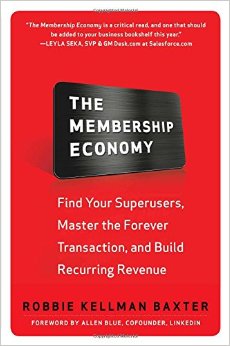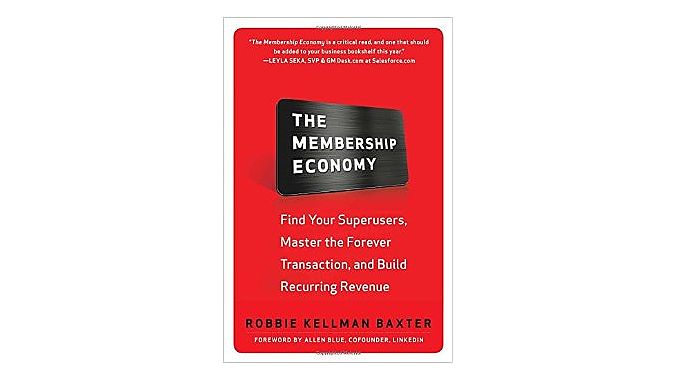Robbie Kellman Baxter wants you to eliminate your customers and replace them with members. And she's written a book to tell you why you should do it, and how.
Her new book, "The Membership Economy", describes a fundamental shift in the way consumers relate to products and services. It's a shift with powerful implications for businesses of all sizes, including small independents like funeral homes, coffee shops, book stores, and, yes, bike shops.
A Stanford MBA and founder of the consulting group Peninsula Strategies, Baxter's clients have included Netflix, Yahoo, Oracle, and Ebay, as well as many smaller companies.
BRAIN: You're no stranger to the bike business.
Kellman Baxter: In 2008, the BPSA invited Nicole DeHoratius, a professor at the Booth Graduate School of Business at the University of Chicago, and me to do some deep research into the state of the U.S. bike business. We presented our findings in the spring of that year at the Bicycle Leadership Conference (BLC). At that time, the conference was attended by both suppliers and retailers. We saw a lot of untapped potential. At a high level, it seemed to us that the suppliers and retailers focused on courting the cycling elite and sort of assuming that by sponsoring races, riders and other events, they would build a strong business. Kind of a trickle down theory of cycling.
But our research showed that the most attractive segments for industry growth were not among these 40-something white guys with five high-end, special-use bikes (one for road racing, one for mountain biking, one made to personal specs, etc.). We saw all kinds of niches going unserved. We also saw some structural barriers in the U.S. that prevented the kind of bike-friendly environment we saw in pockets of the U.S., as well as in other countries. (Note: Although the report was presented at the conference, it was not accepted by the BPSA board of directors. A copy of the report is available here.)
BRAIN: What is the Membership Economy, and why should bike shops care about it?
Kellman Baxter: At the heart of the Membership Economy is a long-term formal relationship between organizations and their customers, or "members." The Membership Economy is a massive trend that has impacted virtually every industry, including cycling. It's about a move from  ownership to access, and from anonymous transactions to known relationships. In the Membership Economy, community and connection can strengthen the connection not just between organization and customer or "member," but also among the members themselves. And these strong ties build loyalty and engagement.
ownership to access, and from anonymous transactions to known relationships. In the Membership Economy, community and connection can strengthen the connection not just between organization and customer or "member," but also among the members themselves. And these strong ties build loyalty and engagement.
We've seen it happening with bike shops for years, as well as at REI and Amazon and online suppliers. They use technology and face-to-face connection to move beyond just selling stuff to delivering on the ongoing mission of the members. Whenever you see people who are real loyal to a brand or a business or a community, there's tremendous potential for creating membership. It's just a matter of figuring out what those people want. If you have people gathering for a Saturday morning ride, that's something they can't get on the Internet. It's also an opportunity to create customer engagement. The most successful bike shops are doing this already; not just having rides, but using the rides to fulfill deeper needs among the riders — to improve, to connect, and to compete.
BRAIN: Is the Membership Economy mostly for the big guys, or can small shops participate?
Kellman Baxter: Bicycle businesses can tap into the power of Membership. You already have brand loyalty and have customers who see succeeding as cyclists as critical to their personal goals. Now you can harness that loyalty to create deeper relationships. This can be true for both large and small retailers.
Retailers have the advantage of really knowing their part of the community. So ask yourself, what else do those people want, and what other needs can you fill for them? You also need to focus on the mission of your customers more than your own products, people and processes. You have to love your customers even more than you love your bikes.
To come up with ideas to build greater loyalty, and to join the Membership Economy, you need to get curious about WHY people want bikes and why they ride them.
BRAIN: Let's go deeper. Can you explain what you mean?
Kellman Baxter: Sure. Why do your customers come into your shop? It's more than just to "have a bike" or to "ride." Why do they want to ride in the first place? The reasons can vary. Maybe it's fitness, in which case you have the opportunity to sell them a whole range of other fitness-based products and maybe offer them regular workouts to complement their independent riding. Maybe they want to achieve a major goal, like a first gran fondo or triathlon. Maybe they want to make friends who enjoy being outdoors. But the big idea is, get close to your customers and find out what they want and need. You're missing out if you don't get the big picture. And you have to remember that not everyone has the same personal mission driving them into your shop.
BRAIN: How does that work for a retail business?
Kellman Baxter: One example might be bookstores. Kepler's, my local bookstore, has moved away from identifying themselves as just a place that sells books and become a true community gathering place for people who care about books. While they still sell books, they also run a paid speaker series, have joint ventures with local schools, and support dozens of book clubs. You can't get that from Amazon. Amazon has other benefits to membership, but it just can't compete in building local community connection.
When a consumer buys a bike, they're also saying a whole bunch of things about how they expect to live their life. The retailer who understands what that means in terms of sales and service is going to be in a position to take advantage of that, because the Membership Economy is about the experience and the customer rather than the products.
BRAIN: What are some specific things bike shops can do to turn customers into members?
Kellman Baxter: In the Membership Economy, members and organizations are aligned around the member's mission — what is it they hope to accomplish by having a bike? How can the organization help them to achieve that goal?
What we want to create is a situation where the member comes back over and over. In the book, I call it The Forever Transaction. It's incredibly powerful because there's a continuous revenue stream for the retailer, there's the opportunity to increase that engagement over time, and because the customer ends up with higher satisfaction and a better experience overall.
Here are four ways we can do this in a retail bike setting:
- Extended warranties. We're all familiar with 30- and 60-day checkups as part of a new bike purchase. Why not expand that program and, for a price, cover all regular service throughout the year, including larger maintenance items like cable replacement, bottom bracket overhaul, flat repair, and grips or bar tape? Priority status during busy summer months for faster turnaround? Or just teaching customers which repairs they can make themselves.
- Tiered pricing. Encourage your members to increase their investment by offering bundled products/services with more value for greater investment. Start with an extended warranty and add pro-rated tire replacement, discounted yearly helmet replacement and other commodity items and throw in unannounced "bonus gifts" (water bottle or cycling socks, even a shop jersey) throughout the year.
- Don't sell bikes, lease them. One of the things I discuss in The Membership Economy is that today's consumers are increasingly interested in access versus ownership. When people buy a car, they may or may not want to own a car; they want access to transportation. Do people even want to own the bike? It's likely most people like riding bikes, and not necessarily owning them. So one possibility is that I lease a bike from you. As part of the price, I get regular service, a discount on other items, and after a year or two years, I turn the bike in to you, and lease another one. And, in between those times, there's no need for me to go anywhere else.
- Know your customers. Recognize them when they walk in (if the Ritz can do it, so can you); call them by name, review their buying history...it makes customers feel like they belong, but it also helps you build loyalty. And recognize your best customers publicly. Not just the fastest racers, but also the people who have done interesting things with their bikes (like losing weight, riding to work, enjoying family time) through pictures on the walls, stories, etc.
Best of all, creating membership opportunities from small business can be done incrementally and on as small a scale as feels comfortable. Small businesses might think they need volume and money to join the Membership Economy, but it's just not true. Local organizations know that there are riches in the niches — the more focused they are, the better able they are to differentiate from big brands.
Robbie Kellman Baxter's The Membership Economy is available at local bookstores as well as Barnes and Noble and Amazon.




